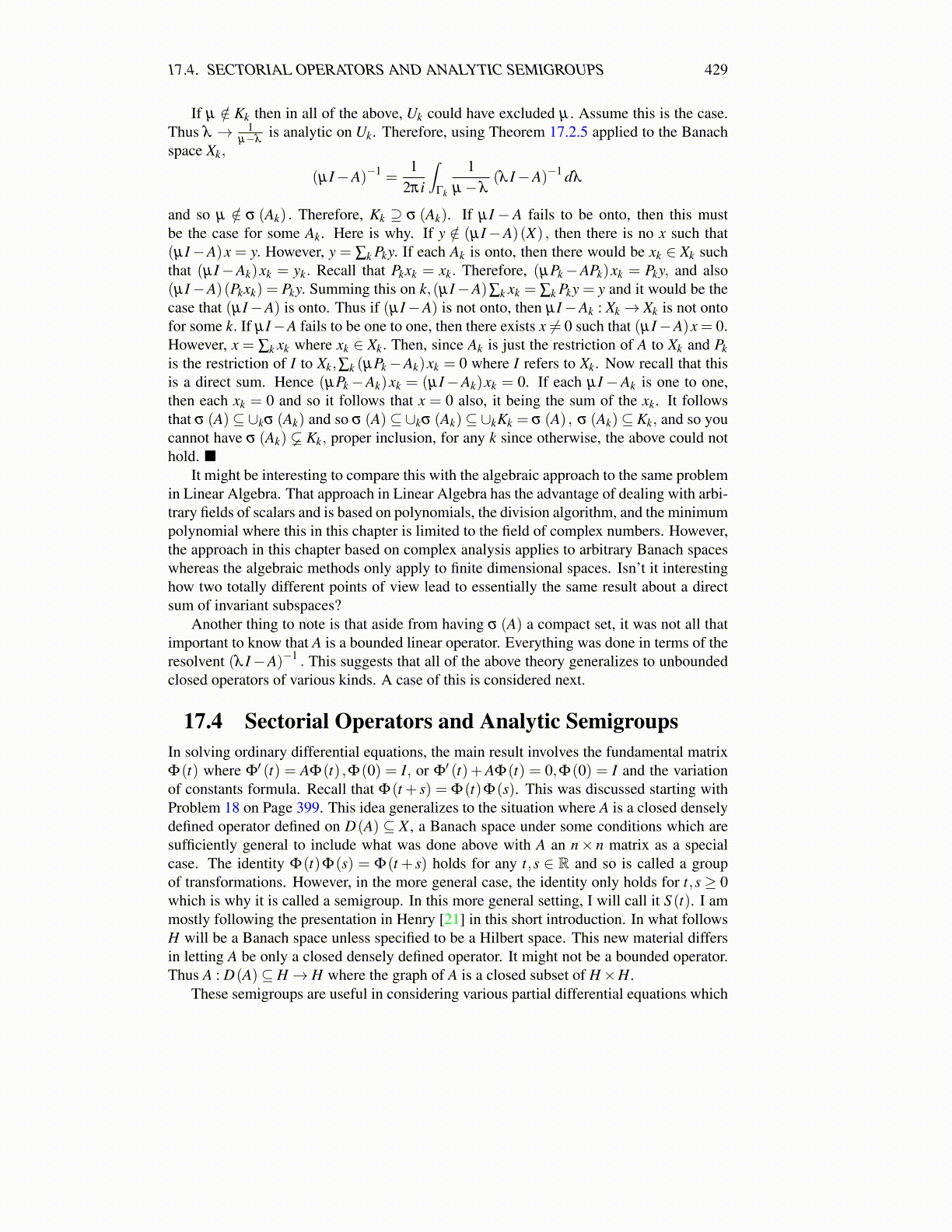
17.4. SECTORIAL OPERATORS AND ANALYTIC SEMIGROUPS 429
If µ /∈ Kk then in all of the above, Uk could have excluded µ. Assume this is the case.Thus λ → 1
µ−λis analytic on Uk. Therefore, using Theorem 17.2.5 applied to the Banach
space Xk,
(µI−A)−1 =1
2πi
∫Γk
1µ−λ
(λ I−A)−1 dλ
and so µ /∈ σ (Ak) . Therefore, Kk ⊇ σ (Ak). If µI − A fails to be onto, then this mustbe the case for some Ak. Here is why. If y /∈ (µI−A)(X) , then there is no x such that(µI−A)x = y. However, y = ∑k Pky. If each Ak is onto, then there would be xk ∈ Xk suchthat (µI−Ak)xk = yk. Recall that Pkxk = xk. Therefore, (µPk−APk)xk = Pky, and also(µI−A)(Pkxk) = Pky. Summing this on k,(µI−A)∑k xk = ∑k Pky = y and it would be thecase that (µI−A) is onto. Thus if (µI−A) is not onto, then µI−Ak : Xk→ Xk is not ontofor some k. If µI−A fails to be one to one, then there exists x ̸= 0 such that (µI−A)x = 0.However, x = ∑k xk where xk ∈ Xk. Then, since Ak is just the restriction of A to Xk and Pkis the restriction of I to Xk,∑k (µPk−Ak)xk = 0 where I refers to Xk. Now recall that thisis a direct sum. Hence (µPk−Ak)xk = (µI−Ak)xk = 0. If each µI−Ak is one to one,then each xk = 0 and so it follows that x = 0 also, it being the sum of the xk. It followsthat σ (A)⊆ ∪kσ (Ak) and so σ (A)⊆ ∪kσ (Ak)⊆ ∪kKk = σ (A) , σ (Ak)⊆ Kk, and so youcannot have σ (Ak) ⊊ Kk, proper inclusion, for any k since otherwise, the above could nothold. ■
It might be interesting to compare this with the algebraic approach to the same problemin Linear Algebra. That approach in Linear Algebra has the advantage of dealing with arbi-trary fields of scalars and is based on polynomials, the division algorithm, and the minimumpolynomial where this in this chapter is limited to the field of complex numbers. However,the approach in this chapter based on complex analysis applies to arbitrary Banach spaceswhereas the algebraic methods only apply to finite dimensional spaces. Isn’t it interestinghow two totally different points of view lead to essentially the same result about a directsum of invariant subspaces?
Another thing to note is that aside from having σ (A) a compact set, it was not all thatimportant to know that A is a bounded linear operator. Everything was done in terms of theresolvent (λ I−A)−1 . This suggests that all of the above theory generalizes to unboundedclosed operators of various kinds. A case of this is considered next.
17.4 Sectorial Operators and Analytic SemigroupsIn solving ordinary differential equations, the main result involves the fundamental matrixΦ(t) where Φ′ (t) = AΦ(t) ,Φ(0) = I, or Φ′ (t)+AΦ(t) = 0,Φ(0) = I and the variationof constants formula. Recall that Φ(t + s) = Φ(t)Φ(s). This was discussed starting withProblem 18 on Page 399. This idea generalizes to the situation where A is a closed denselydefined operator defined on D(A) ⊆ X , a Banach space under some conditions which aresufficiently general to include what was done above with A an n× n matrix as a specialcase. The identity Φ(t)Φ(s) = Φ(t + s) holds for any t,s ∈ R and so is called a groupof transformations. However, in the more general case, the identity only holds for t,s ≥ 0which is why it is called a semigroup. In this more general setting, I will call it S (t). I ammostly following the presentation in Henry [21] in this short introduction. In what followsH will be a Banach space unless specified to be a Hilbert space. This new material differsin letting A be only a closed densely defined operator. It might not be a bounded operator.Thus A : D(A)⊆ H→ H where the graph of A is a closed subset of H×H.
These semigroups are useful in considering various partial differential equations which